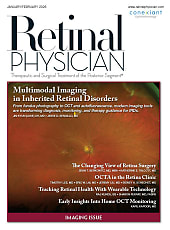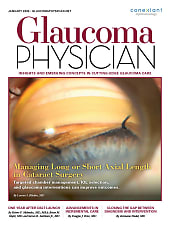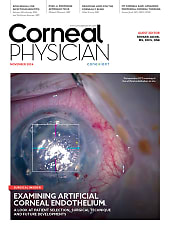Central serous chorioretinopathy (CSCR) is a relatively common disease affecting the retina. It was first reported in 1866 by the German ophthalmologist Albrecht von Graefe, who described it as a “recurrent central retinitis.”1 Central serous chorioretinopathy is more likely to affect men than women. In most cases, onset of the condition usually occurs between the ages of 25 and 50 years.
Clinically, it is largely bilateral. CSCR appears as a localized serous detachment of the neurosensory retina involving the region of the macula without subretinal blood or lipid exudates.2 CSCR is associated with one or more areas of leakage from the choroid through a defect in the retinal pigment epithelium (RPE) outer blood-retina barrier.3 This leakage is thought to be attributed to sausaging and bulbosities of choroidal blood vessels, leading to choriocapillaris and subsequent leakage.4 This ciliochoroidal effusion, also known as leakage accumulation, tends to amass as subretinal fluid and is associated with areas of increased choroid thickness.
Typically, treatment involves removing inciting agents followed by observation. For chronic cases, the current standard of care is photodynamic therapy (PDT) with verteporfin (Visudyne, Bausch + Lomb).
There have been multiple studies involving topical or oral treatment, as well as treatment with both subthreshold micropulse laser and conventional thermal laser. A recent study suggests that half-fluence photodynamic therapy may be even more beneficial in treating early cases of CSCR.3 An additional benefit of half-fluence photodynamic therapy is a lack of adverse effects compared to subthreshold micropulse laser treatment or mineralocorticoid treatments such as oral eplerenone.5 Studies have also shown the possibility of vascular endothelial growth factor (VEGF) inhibitors being used for the treatment of CSCR.6,7 In cases of acute CSCR, VEGF inhibitors have shown no benefit; however, in cases of chronic CSCR there is some suggestion that anti-VEGF treatment may be beneficial.
The pathogenesis of this condition is ambiguous and multifactorial. Risk factors include increased scleral thickness of the posterior and equatorial portions of the eye, but CSCR is also believed to be linked to several phenomena, most notably to conditions with elevated cortisol levels.2,8,9,10 There have also been studies nodding to a link to corticosteroid usage.11 Additional studies have hinted at potential links to psychosocial stress such as anxiety and highly intense or competitive environments and behaviors,12,13 as well as to Type A behavioral characteristics (extreme competitiveness, striving for achievement and personal recognition, aggressiveness, impatience, and explosiveness) as identified on the Jenkins Activity Survey.14 A study also hinted that exercise may prevent retinal microcirculation from managing blood pressure and ocular perfusion pressure in patients with CSCR.15 These links to Type A behavior, physiological and psychosocial stress, and cortisol levels, while not fully explored in addition to the robust response to anti-VEGF treatment, can all be attributed to the patient highlighted in this report.
CASE SUMMARY
Our case involves a 55-year-old male who presented with complaints of bilateral vision loss. Examination revealed corrected visual acuities 20/60 OD and 20/25 OS and an unremarkable anterior segment. The retinal exam was remarkable for multiple bilateral neurosensory detachments consistent with bilateral multifocal central serous chorioretinopathy (Figure 1).

The patient denied steroid use of any kind, but his family strongly endorsed the idea that he had a Type A personality. After further questioning it was revealed that the patient obsessively engaged in strenuous exercise daily. This could involve daily CrossFit sessions followed by additional workouts at home, including lengthy bike rides and several marathon-distance runs a week. The presentation of the CSCR at each clinical visit seemed to reflect the past activity levels of the individual.
Upon returning to the clinic with worsened CSCR symptoms, lengthy discussion ensued regarding the nature of the patient’s physical activity. Serum cortisol levels can be significantly elevated after periods of intense exercise, so it was suggested that the intense exercise was the exacerbating issue and that changing or limiting the exercise—and thus, the cortisol levels—could help control his disease. To test this, the patient was instructed to abstain from exercise, except for walking, for a period of six weeks, after which he would be examined to see whether the symptoms and neurosensory detachments had changed. At the six-week interval, there was a striking resolution of the fluid (Figure 2). The patient was then instructed to return to his normal exercise routine, after which the leakage returned to its typical appearance. When the patient returned to walking only as exercise for a second time, the fluid resolved again. We surmise that the exercise-induced increase in circulating cortisol levels was the issue that tipped the balance against the already fragile RPE.

The patient is interesting for a second reason. He was lost to follow up for 5 years and returned with profound visual loss in the right eye that he felt was longstanding. The exam showed vision had deteriorated to 20/800 OD and 20/30 OS and the maculas showed not only significant atrophic changes in both eyes but also extensive subretinal and sub-RPE fluid bilaterally. PDT was considered but initially avoided due to the diffuse preexisting RPE damage. The patient elected to accept treatment in the form of anti-VEGF aflibercept (Eylea, Regeneron). This treatment method is not primarily used for CSCR—Eylea is off-label for this indication—but due to persistent diffuse RPE damage and the extensive multilayer fluid it was felt there may be an element of occult choroidal neovascularization present. Injections were initiated starting in the left eye due to it being the eye with better visual acuity and less severe edema. The patient began to see improvement in the left eye after receiving injections for four months (Figure 3). Upon confirming the success of Eylea treatment, injections in the patient’s worse right eye were initiated. After 9 injections OD over 11 months, the patient’s visual acuity had significantly improved from 20/400 to 20/150, stabilizing at 20/250. It also stabilized at 20/25 in the left eye with complete resolution of all fluid OU (Figure 4).


DISCUSSION
We find this case of central serous chorioretinopathy important to report as it has two significant and interesting facets: it is possibly a case induced by obsessive extreme exercise, and the CSCR responded to the reduction in exercise early and later responded to treatment with a VEGF inhibitor. This case of CSCR is one unusual case with suspected component of occult choroidal neovascularization.16,17,18 Upon treatment with Eylea, the patient demonstrated improving visual acuity and rapidly reduced subretinal and sub-RPE fluid levels. Typical treatment depending on the underlying cause is lifestyle/med adjustment and half-fluence photodynamic therapy (PDT).7,15,18 Here these were not used due to patient wishes, yet were possibly not needed due to the disease’s responsiveness to the VEGF inhibitor.
This study suggested that maximal benefit may result from early intervention to limit deterioration of visual acuity seen by many patients and could warrant further exploration of anti-VEGF therapy on a broader clinical scale. NRP
REFERENCES
- von Graefe A. Über zentrale rezidivierende retinitis. Graefes Arch Ophthal. 1866;12:211.
- Semeraro F, Morescalchi F, Russo A, et al. Central serous chorioretinopathy: pathogenesis and management. Clin Ophthalmol. 2019;13:2341-2352. doi:10.2147/OPTH.S220845
- van Rijssen TJ, van Dijk EHC, Yzer S, et al. Central serous chorioretinopathy: towards an evidence-based treatment guideline. Prog Retin Eye Res. 2019;73:100770. doi:10.1016/j.preteyeres.2019.07.003
- Spaide RF, Ngo WK, Barbazetto I, Sorenson JA. Sausaging and bulbosities of the choroidal veins in central serous chorioretinopathy. Retina. 2022;42(9):1638-1644. doi:10.1097/IAE.0000000000003521
- Gawęcki M, Jaszczuk-Maciejewska A, Jurska-Jaśko A, Kneba M, Grzybowski A. Transfoveal micropulse laser treatment of central serous chorioretinopathy within six months of disease onset. J Clin Med. 2019;8(9):1398. doi:10.3390/jcm8091398
- Gülkaş S, Şahin Ö. Current therapeutic approaches to chronic central serous chorioretinopathy. Turk J Ophthalmol. 2019;49(1):30-39. doi:10.4274/tjo.galenos.2018.49035
- Lim JW, Kim MU, Shin MC. Aqueous humor and plasma levels of vascular endothelial growth factor and interleukin-8 in patients with central serous chorioretinopathy. Retina. 2010;30(9):1465-1471. doi:10.1097/IAE.0b013e3181d8e7fe
- Terao N, Imanaga N, Wakugawa S, et al. Ciliochoroidal effusion in central serous chorioretinopathy. Retina. 2022;42(4):730-737. doi:10.1097/IAE.0000000000003376
- Garg S, Dada T, Talwar D, Biswas N. Endogenous cortisol profile in patients with central serous chorioretinopathy. Br J Ophthalmol. 1997;81(11):962-964. doi:10.1136/bjo.81.11.962
- Haimovici R, Rumelt S, Melby J. Endocrine abnormalities in patients with central serous chorioretinopathy. Ophthalmology. 2003;110(4):698-703. doi:10.1016/S0161-6420(02)01975-9
- Sharma T, Shah N, Rao M, et al. Visual outcome after discontinuation of corticosteroids in atypical severe central serous chorioretinopathy. Ophthalmology. 2004;111(9):1708-1714. doi:10.1016/j.ophtha.2004.03.025
- Conrad R, Geiser F, Kleiman A, Zur B, Karpawitz-Godt A. Temperament and character personality profile and illness-related stress in central serous chorioretinopathy. Sci World J. 2014;2014:631687. doi:10.1155/2014/631687
- Spahn C. Psychosomatic aspects in patients with central serous chorioretinopathy. Br J Ophthalmol. 2003;87(6):704-708. doi:10.1136/bjo.87.6.704
- Yannuzzi LA. Type-A behavior and central serious chorioretinopathy. Retina. 1987;7(2):111-131.
- Cardillo Piccolino F, Lupidi M, Cagini C, et al. Retinal vascular reactivity in central serous chorioretinopathy. Invest Ophthalmol Vis Sci. 2018;59(11):4425. doi:10.1167/iovs.18-24475
- Filho MAB, de Carlo TE, Ferrara D, et al. Association of choroidal neovascularization and central serous chorioretinopathy with optical coherence tomography angiography. JAMA Ophthalmol. 2015;133(8):899-906. doi:10.1001/jamaophthalmol.2015.1320
- Gomolin JE. Choroidal neovascularization and central serous chorioretinopathy. Can J Ophthalmol. 1989;24(1):20-23.
- Loo RH, Scott IU, Flynn HW, et al. Factors associated with reduced visual acuity during long-term follow-up of patients with idiopathic central serous chorioretinopathy. Retina. 2002;22(1):19-24. doi:10.1097/00006982-200202000-00004
- Subhi Y, Bjerager J, Boon CJF, van Dijk EHC. Subretinal fluid morphology in chronic central serous chorioretinopathy and its relationship to treatment: a retrospective analysis on PLACE trial data. Acta Ophthalmol. 2022;100(1):89-95. doi:10.1111/aos.14901








